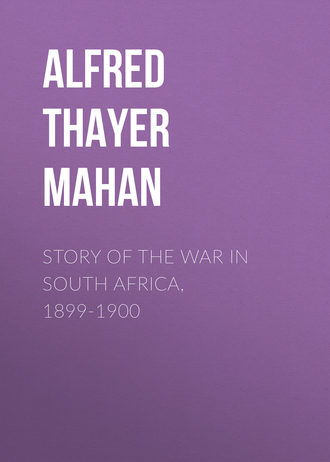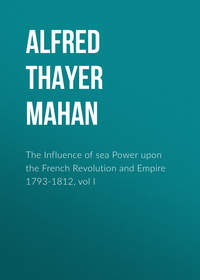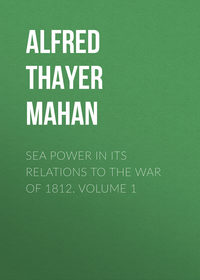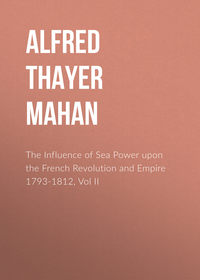 полная версия
полная версияПолная версия
Story of the War in South Africa, 1899-1900
The railroad from Ladysmith to Glencoe passes therefore through a district the nature of which is favourable to rapid advance or retreat of mounted men, as the Boer forces chiefly are, and which at the same time is marked by frequent and steep detached elevations, adapted for defensive positions hastily assumed. These conditions, with the nearness of the declivities of the western mountains, and the proximity of the enemy's frontier, behind which movements of troops would be "curtained"—to use a graphic military metaphor—gave the Boers particular facilities for striking unexpectedly the railroad between Ladysmith and Glencoe, upon which, in defect of other transportation, the two British posts must depend for communication between themselves, and with their base on the sea.
Further to the south, movements of the same kind would be decisively more difficult. Not only would the Boers there be further from their base, and the British nearer theirs, but the country is less favourable to rapid horse movements, the line of the rail is contracted by lofty and continuous ranges of hills, the space between which gives but a narrow front to be covered by a defence, and the river beds, as already said, are broader and deeper; notably, of course, the Tugela. Moreover, not only are the mountains on the western frontier higher and more difficult as one goes south, they are also more remote; and, south of Colenso, form the boundary of Basutoland, upon which the Boers could not intrude without arousing armed resistance by the blacks. All these conditions are more favourable to a pure defensive attitude, which was that imposed at the outset upon the British, because they were then numerically the weaker party.
And here at once must be made a distinction, which for intelligent comprehension it is essential to keep in mind. Putting entirely to one side all question of the merits of the quarrel—of its right or its wrong—it must be steadily remembered that, although the comparative aggregate strength of the two parties placed the Boers from the first on the defensive in the general sense, they were at the beginning of hostilities decisively superior in local force, and would so remain until sufficient reinforcements from Great Britain should arrive to turn the scale. Under such circumstances, correct military principle—and the Boers have had good advisers—imperatively dictates that the belligerent so situated must at once assume an active offensive. By rapid and energetic movement, while the opponent's forces are still separated, every advantage must be seized to destroy hostile detachments within reach, and to establish one's own front as far in advance of the great national interests, as it can be reasonably hoped to maintain it with communications unbroken. The line thus occupied must rest upon positions so chosen that by their strength, natural and developed, it shall be possible, when offence has to be exchanged for defensive warfare, to impose to the utmost upon the invader both delay and loss; for delay and loss mean lessening power, and only by causing such diminution, greater relatively than his own, can the weaker hope eventually to reverse the odds and win the game.
To this end, therefore, the Boers with sound military judgment at once devoted themselves; and it is very likely that the surmise before quoted was correct—in naming the Hex River Pass and Durban as their ultimate objectives, to be reached by a swift advance. The latter was certainly not an unreasonable hope, and it is possible that with more precise accuracy of combination, and an offensive more resolutely sustained, they might have attained their purpose, through the mistaken primary dispositions of the British, who, though recognizing themselves to be for the time on the defensive, nevertheless, for political reasons, advanced their front of operations to a point with which, as it proved, they could not secure their communications. From the worst consequences of this error they were saved by the gallantry and skill with which advantage was taken of the defective co-operation that marked the opening of the campaign by the Boers; and there can be also little question that the wholesome respect for their fighting qualities, thus established at the beginning of hostilities, had a most beneficial effect for them, in discouraging attack by an enemy, who, though brave and active, constitutionally prefers a waiting game to an assault. Thus the ultimate fate of Ladysmith was settled in the fortnight of operations that preceded the investment.
CHAPTER II
THE OPENING CAMPAIGN IN NATAL TO THE INVESTMENT OF LADYSMITH (OCTOBER 11-NOVEMBER 2)
The evident exposure of Natal to the first and heaviest attack of the enemy, and the necessity so to provide for its defence as to gain the time necessary for reinforcements to arrive, engaged very early the anxious attention of the Imperial and local authorities. The latter especially felt the greater solicitude, which is natural to those whose interests are immediately threatened. As early as May 25, before the Bloemfontein Conference between Sir Alfred Milner and President Kruger, the Natal Ministry notified Mr. Chamberlain that, owing to Boer preparations across the border, the scattered British in the neck of Natal were getting uneasy, and the Ministry itself nervous, at the prospect of war. These representations were repeated more urgently in the middle of June, and a month later a request was made to be confidentially informed of the proposed plan for defence. When this was communicated, it appeared that General Sir Penn Symons, commanding the Imperial troops in Natal (who afterward was the first general officer killed in the war), considered that with the force then at his disposal—something over 5,000 men of all arms—he could do no more than hold the railroad as far as Hattingh Spruit, some five miles north of Dundee, thereby protecting the collieries. To advance as far as Newcastle he estimated would require 2,000 more, while to hold Laing's Nek an addition of 5,600 would be needed.
These calculations, as is now known, fell far short of the necessities of the case, but they sufficiently alarmed the Colonial Government, and upon its remonstrance the British Cabinet, on August 3, decided to send a reinforcement of 2,000 men.
On the 6th of September the Governor of Natal telegraphed at length to London many menacing symptoms observable among the Boers, from which war was believed to be inevitable, and urged the immediate despatch of troops sufficient to protect the colony. In response to this, orders were issued on September 8 for 5,700 men to start from India, and a small additional force from England itself, making a total of from seven to eight thousand. These were expected to arrive, and actually did for the most part arrive, between October 12 and 19, but even so were barely in time for the critical moment. They were also only sufficient imperfectly to defend the colony, and were by no means adequate to the offensive purpose which the Boer Government, in its ultimatum, professed to discern.
Meanwhile, on the 25th of September, Glencoe had been occupied by a detachment from Ladysmith, while reinforcements were sent to the latter. It had by this time been recognized that the attempt to hold the more advanced positions, such as Newcastle and Laing's Nek, would expose the forces so placed to the fate of isolation which afterward befell Ladysmith. The course of both the Imperial and colonial governments at this period was much affected by a wish not to precipitate hostile action on the part of the Boers; for, in general, war was not desired by the British, and, in particular, they were as yet unready. On the 28th, however, such definite and threatening movements were reported that the Natal Ministry decided at all hazards to call out the volunteers, although it had apprehended that this step would be considered practically equivalent to a declaration of war.
The increase of force in Natal to 15,000 men determined the sending out of an officer superior in rank to General Symons. Sir George White, designated for this duty, reached Cape Town October 3, and in view of the serious news he there received, proceeded at once to Durban. On the 9th, the day the Boer ultimatum was issued, he had at Pietermaritzburg an interview with the Governor, in which he expressed his disapproval of the position at Glencoe—an opinion in which other officers of rank present coincided. The Governor replied that General Symons had thought it safe, even before the Indian contingent arrived; that the step had been taken to assure the coal supply; and that to recede from it now would involve grave political consequences, disheartening the loyal, and tending to encourage a rising among the blacks and the disaffected Dutch. Without changing his opinion as to the military error involved, Sir George White resolved to allow the detachment to remain. The decision thus taken finally constituted the British military situation in Natal when the campaign opened; namely, an advanced detachment of three or four thousand at Glencoe and Dundee, a main body of eight to ten thousand at Ladysmith, with smaller posts guarding the communications in rear of the latter.
The greater exposure of Natal, owing to its nearness to the Boer States, had determined the concentration upon it of the bulk of the British forces in South Africa, including the reinforcements so far ordered; by the arrival of which it was expected that there would by the end of October be 22,000 troops in South Africa. It was not till October 7 that was issued the first order to mobilise, summoning 25,000 of the Army Reserve to join the colours.
The necessities of Natal left but scant numbers to Cape Colony, which was comparatively of less consequence, because the points of vital importance to Great Britain lay near the sea-coast, protected by their mere remoteness from any speedy attack. On the far inland borders of the colony the situation soon reduced itself to that with which we were so long familiar. The four or five thousand men available at the outbreak of the war for the defence of the long frontier, extending over five hundred miles, from the Basutoland boundary to Mafeking, were obliged by the necessities of the case to concentrate; which they did at Mafeking and Kimberley. There they were speedily invested; and, being thus held in check, the border country, including the important railroad junctions of De Aar, Naauwport and Stormberg, lay freely open to the enemy. The seriousness of this military condition was much increased by the well-known political fact that the Dutch population of the region sympathized more or less actively with the Boers. In fact many of them, upon the opening of hostilities, crossed the border to join the forces of the Orange Free State.
On the 9th of October, 1899, the Transvaal Government presented an ultimatum. After recounting the political grievances of which it complained, it demanded that all points of mutual difference should be settled by arbitration, or other peaceful means, that the British troops near the Transvaal border should be withdrawn, that the recent reinforcements be removed altogether from South Africa, and that those still on the sea should not be landed. If a satisfactory answer were not received by 5 P.M., October 11, the action of the British Government would be regarded as a formal declaration of war. War therefore may be considered as having been formally initiated by the Transvaal, at the day and hour thus fixed.
For some time prior to the opening of hostilities, the armed men of both the South African Republic and the Free State had been assembling in force on their respective frontiers toward Natal; the latter less rapidly than the former, its military preparation not having received as full development as that of its ally, who for some years had been contemplating the possibility of war and accumulating material. The Transvaalers came in rapidly, and already by the end of September had gathered in numbers enough to warrant a speedy advance, before the expected reinforcements from India should reach the enemy.
There is good reason to believe that it was intended to issue the ultimatum on October 2, a week before its actual date; but there occurred the unpleasant surprise of finding that neither in food nor in ammunition were the supplies at hand sufficient to justify an immediate forward movement. The defect of imperfect transport organisation, inherent to hastily levied irregular troops, made itself at once felt. The delay doubtless strengthened both parties, but, as usual, inured most to the benefit of the one then on the defensive.
The first transports from India began to arrive on Tuesday, October 3, on which day also the bulk of the Natal volunteers were expected to be in their places; and in the six intervening days, preceding the ultimatum, eleven more steamers entered Durban with troops which were at once despatched to the front. General Symons took command at Dundee, Sir George White of the main body at Ladysmith.
The number of the Boers near at hand, and capable of being brought against either of the British posts, was variously estimated at the moment at from 8,000 to 13,000. There can be little doubt, however, that the latter figure was much more nearly correct; that, in fact, on October 11, the available force for the invasion rather exceeded than fell short of the higher figure. Although precise information is still lacking, there can be no doubt, from the character of the Boer operations, that rapid subsequent accessions raised their numbers in Natal to near 30,000 before the middle of November.
It is well here, on the verge of opening hostilities, to recall what has before been indicated, that the projection of the narrow neck of Natal, forming an acute salient angle between two hostile borders, gave especial facilities to the Boers to combine their movements outside the observation of the enemy, and to strike suddenly either at one of the British detachments, or at the railroad uniting them. Small bodies began to make their appearance from both quarters almost immediately after the expiry of the time set by the ultimatum, and for three or four days the ordinary reports of outpost observations and shots exchanged were continually received.
The uncertainty consequent upon these divergent demonstrations, some of which from the Free State seemed to aim at the rear of Ladysmith itself, was balanced and checked by the knowledge that the principal Transvaal force had assembled round Zandspruit, in its own territory, near the railroad, and some fifteen miles beyond Majuba Hill. There was reason also to believe that the Transvaalers would be found more enterprising and numerous than the Free State men. It was, therefore, natural to expect that the main attack would come from the north along the railroad, and from the east, where the approach from the Transvaal boundary, which is there marked by the Buffalo River, is over a country much more practicable than the western mountain range. These considerations in fact appear to have dictated the first combination of the Boers.
Within a week from the opening of hostilities, the latter had occupied Newcastle, thirty-seven miles by rail from Glencoe. On the 18th further demonstrations caused General Symons to withdraw the outpost stationed at Glencoe to the camp, which was a mile and a half west of Dundee. The following day, Thursday, he received information, which proved to be in the main accurate, that a combined movement was in progress by which his position was to be simultaneously attacked from the north and from the east. The force in the latter direction was given at 7,000—probably an excessive estimate; although, as several commandos had been reported on Wednesday to be moving from the northern toward the eastern column, it is probable that the latter was expected to make the chief attack. A British reconnaissance on the same evening had showed the enemy apparently in force some ten miles to the northward on the railway; but, if an attack from that quarter were intended, the Boer combination failed, for none was made. General Joubert, in reporting the results, said, "Commandant Lucas Meyer (commanding the eastern force) has had an engagement with the British at Dundee. Meyer made a plan of campaign by messenger with Commandant Erasmus, who, however, did not put in an appearance." Convergent attacks, intended to be simultaneous, but starting from different quarters, are particularly liable to such mishaps.
While these two columns on the 18th were moving on Dundee, a third force of about 1,000 mounted men, under General Koch, coming from the north, passed round Glencoe to the westward, crossing the Biggarsberg, a lofty spur of nearly 6,000 feet, that extends from the western mountains almost across Natal, with occasional depressions, through one of which the railroad passes. On Thursday these took possession of Elandslaagte, a station sixteen miles north of Ladysmith, capturing one train and nearly intercepting another. Railroad communication in the rear of Symons was thus intercepted, at the moment that Meyer was advancing from the east, expecting to fall upon him in conjunction with the northern column. During the night of the 19th Meyer's force crossed the Buffalo River at Landman's Drift, ten miles east of Dundee, at 2.30 A.M. drove in the British pickets in that direction, and at daybreak was seen dotting the hill-ridges, about three miles east of the camp.
The scene of the approaching action of October 20 is the valley of a small stream, the general course of which, as nearly as can be judged from the maps, is north and south. The river-bed, or donga—to use the conveniently short South African term—is half a mile east of Dundee, the ground sloping easily toward it; while on the other side the watershed rises, slowly at first, afterward more rapidly, for a mile or more, to the ridge occupied by the Boers, which the road to Landman's crosses at a depression called Smith's Nek. The enemy were on both sides of the latter when first seen by the British. To the north of the Nek—to the Boer right—is Talana Hill, where the decisive fighting occurred, and which had to be carried by direct assault, lasting, with the intervals of cover, for nearly six hours. The characteristics of the Hill itself, therefore, need to be understood. As described by an eye-witness, it is about eight hundred feet high from the level of the donga. The summit presents the flat table-like sky line, frequently noted in South African travel, of which Table Mountain, in Cape Town, is the conspicuous example. After a few hundred yards of gentle acclivity through open ground a wood is reached, near which is a homestead called Smith's Farm. Half way between the wood and the top is a stone wall supporting a terrace. Between the wood and this wall the ground is steep, broken and rocky. Immediately above the wall the terrace, though easy, is wide and open, and consequently exposed. The terrace crossed, the remainder of the ascent is almost perpendicular; a matter therefore of strenuous climbing under fire.
It appears from this description that the wood and the terrace afforded a certain amount of cover, as did the donga; that the first rush from the latter could be made rapidly, with, however, comparatively little shelter from a long-range fire, while to climb the wall and cross the terrace, though a short process, involved the utmost exposure. Concerning the last scene of the drama, the scaling the nearly precipitous fronts which skirted the Boers' position, the difficulty of the achievement caused the losses of the assailants there to be heaviest. It may be added that, owing to the unexpected and rapid developments of the day, most of the British fought without breakfast or other food.
As soon as the enemy were discovered a company of infantry occupied the donga, where successive reinforcements were received, and under cover of which the line prepared for the assault. At 5.30 the Boers surprised the British by opening with artillery—six guns—at an estimated distance of 5,400 yards from the British camp. To this three batteries replied, two of which were soon moved down to the town side of the donga. The artillery duel, at a range of 2,000 to 3,000 yards, continued until toward eight o'clock, when the Boers ceased firing, and General Symons gave the order to prepare for the assault. Difficult as was the task, and inferior though the assailants were in number, the conditions were such that the weak garrison of Dundee had no prospect of ultimate escape, unless they could rout the enemy with which they were engaged before the co-operating body from the north arrived.
While the action was in its early stages, at 10 A.M., scouts reported a large force approaching along the railroad. The small detachment left to guard the British camp moved out to meet and, if possible, to delay this new enemy. Besides the purely local conditions, it was essential, in the general plan of campaign, during the waiting period of inferiority, while their reinforcements were still on the sea, that the British should risk much to demoralise and daunt an enemy who, whatever their advantages otherwise, had not that military training and cohesion which facilitates rapid recovery from a reverse. Whatever the first mistake of advancing their position so far, it is impossible to withhold admiration from the rapidity and energy of the measures taken in the first fortnight of the campaign.
It was a dull, drizzling morning when the line of hungry British soldiers leaped from the donga and rushed for the wood; their batteries to the right and left sending a rapid continuous iron fire over their heads upon the hill-top, whence the Boers rained down lead upon their advance. Few dropped here; but in the wood, where for quite a while they halted, concealed rather than covered, many were struck down, and here it was that death found General Symons, who had galloped up to tell the men the hill must be taken. He had asked much of his men, but he spared not himself. He fell honoured and beloved; man cannot die better.
It was about 10 that Symons received his wound. Obedient to his last commands, the troops broke cover and worked their way from the wood to the wall, step by step; a few feet onward, rushed and down; again a rush and again down. Below the terrace they stopped, protected by the wall but unable to advance; for did man show head or hand, down swept the deadly fire from above. Men, however, are not of iron; eyes and hands weary; the brain and the nerves feel strain; and it is of the essence of defence that it exhausts quicker than does offence. It lacks intrinsically the moral tension that sustains; when the forward impulse is removed, the evil spirit of backwardness finds room to enter. As hours pass, this difference in moral conditions affects those which are external—saps physical endurance.
Whatever the reason, toward noon the Boer fire slackened; possibly the necessity of husbanding ammunition was felt. The British scaled the wall, crossed rapidly the terrace, and gained the foot of the last steep climb which lay between them and the enemy's position. Their artillery also moved forward, to sustain the final perilous attempt by keeping down the enemy's fire; but, despite all it could do, the loss here was great and fell especially heavily upon the officers, who exposed themselves freely. Out of seventeen of the latter that went into action with one battalion, five were killed and seven wounded; and the other regiments suffered in like manner, if not to the same degree. As the assailants got near the top, the batteries had to cease firing, unable longer to assure their aim between friend and foe. The last rush was then made with the bayonet, but, as is usual, the defendants did not await the shock of immediate contact. They broke and fled as the British advance crowned the summit, leaving there some thirty dead and wounded, besides seventy wounded in a field hospital on the reverse side of the hill. The artillery of the attack continued to move forward to Smith's Nek, whence the enemy's force was visible in full retreat. It was at 1.30 P.M. that the position, which General Yule, Symons's successor, styled "almost inaccessible," was finally carried.
The precise numbers engaged can as yet be only a matter of estimate, but there is little doubt that the assailants were inferior in number to the defenders. The former were about 2,000; the latter were by General Yule thought to be about 4,000, many of whom, doubtless, were not on the hill itself. The satisfaction of the victors, in what was certainly a splendid feat of arms, was somewhat marred by the disappearance of a body of cavalry, which at the opening of the day had been sent to work round the enemy's right—northern—flank. They had been taken prisoners, apparently by the co-operating Boer force which had failed to come up in time for the fighting.











